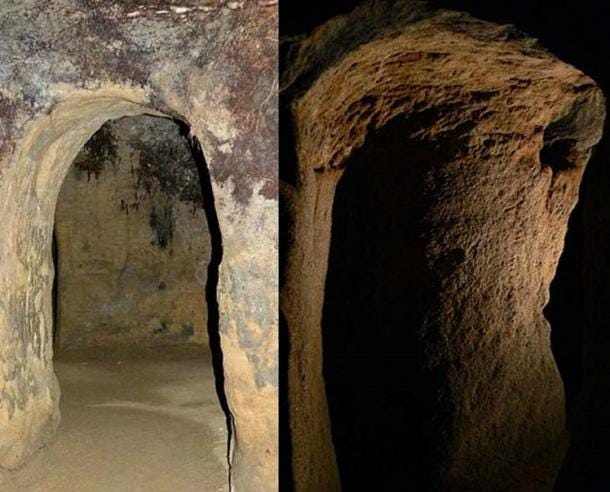We have heard of all these for a long time and i have even posted on them. obviously these are cultural artifacts with zero cultural explanation and could easily be even tens of thousands of years old, although they are most likely Bronze Age tech.
Understand that tunneling was done using a blow torch to popcorn the rock. the limitation would be air flow tubes. We are just now reinventing this tech.
Of course, i could be wrong, but then we need to see hammer marks and chisel marks. both also need ample driving room and these chambers are quite small human sized and no one is swinging an aimed maul here without breaking his leg.
The best explanation is shamanic meditation rooms. This would be welcome enough for a community to commission the building of one from a traveling mining team.
We literally have thousands out there and they certainly were specialty builds as well but also super secure and safe. We do have a tradition of meditation caves in the Himalayas and this allows a long meditation lasting weeks with food supplied.
.
Unraveling the Mystery of Europe’s Mysterious Erdstall Tunnels
AUG 9
https://www.ancientoriginsunleashed.com/p/unraveling-the-mystery-of-europes?
The erdstall is type of tunnel prominently found scattered across Europe, predominantly in Bavaria, southeast Germany, and Austria. Thought to be crafted during the Medieval period, some theorists argue that these ancient subterranean structures date back to the Stone Age. The purpose of these mysterious tunnels remains a tantalizing enigma. Advocates for the Stone Age theory propose that these tunnels formed an extensive underground network stretching from Scotland to Turkey.
Erdstall Construction
The term 'erdstall' originates from German, signifying 'earth stable' or 'mining tunnel.' While there are various kinds of subterranean tunnels worldwide, the erdstalls have unique characteristics that set them apart. Typically, an erdstall network includes narrow, low tunnels, often oval-shaped and running either vertically or horizontally. These intriguing tunnels usually span between 20 and 50 meters. An especially distinctive feature is the 'schlupf' or 'slip out' – incredibly tight holes (around 40 cm in diameter) connecting tunnels at different levels.
Man exploring a horizontal passage or ‘slip out’ in an erdstall ( GFDL)
Venturing into the Shadowy Depths of Erdstall
Currently, Europe is home to an estimated 2000 erdstalls, with Bavaria in Germany housing the lion's share of around 700. Its neighboring country, Austria, is not far behind with about 500 erdstalls. Countries like the UK and France also host these enigmatic underground passages.
Erdstall tunnels in Austria. Left: ( CC BY-SA 3.0 ) Right: ( CC BY-SA 3.0 )
The Cryptic Function of Erdstalls
The intended use of these erdstalls is still shrouded in profound mystery. In some local lore, the tunnels are believed to be the dwellings of mythical creatures like elves and gnomes, thought to have constructed them. Consequently, erdstalls often receive whimsical names reflecting these tales, like 'Schrazelloch' ('goblin hole') or 'Alraunenhöhle' ('mandrake cave'). Some believe they were secret escape routes linked to castles as some sagas suggest. However, this theory hits a snag as erdstalls typically have a single entry and exit point, rendering them unsuitable for such a purpose.
A map of erdstalls showing typical dead-end design ( CC BY-SA 2.0 )
A Bold Assertion and its Hurdles
Others theorize these tunnels as hideouts, though their narrow dimensions and lack of airflow, due to the single entry-exit, would make it a rather inhospitable refuge. Some argue that the erdstalls were storage facilities, but the tight space and occasional waterlogging (especially in winters) deem it unlikely.
Sitting recess at the end of an erdstall tunnel ( GFDL )
One of the most intriguing assertions suggests that these erdstalls were parts of an enormous subterranean network stretching from Scotland to Turkey. Further, they propose this network dates back to the Stone Age, dubbing it as an "ancient underground superhighway" for safe interregional travel. This theory, however, grapples with numerous issues, including the fact that the erdstalls aren't interconnected and are structurally dissimilar to the vast underground cities found in Turkey's Cappadocia regions.
Erdstalls remain a fascinating enigma. Despite the many theories and speculations about their origins and purpose, definitive answers are still elusive. Nevertheless, the study of these structures provides an intriguing glimpse into the past, and could potentially lead to new discoveries about the societies that built them. Their mysteries continue to captivate scholars, adventurers, and anyone with a curiosity for the unknown.
Top image: Erdstall entrance, Erdstall Ratgöbluckn, Austria ( CC BY-SA 3.0 )
By Wu Mingren





No comments:
Post a Comment